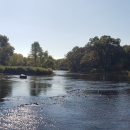About Us
Sherburne National Wildlife Refuge is located in Sherburne County, in east central Minnesota, about 50 miles northwest of the Minneapolis and St. Paul metropolitan area. The 30,700 acre refuge was established in 1965 at the urging of local conservationists and hunters interested in restoring the wildlife values of the St. Francis River Basin, which had been altered by a series of drainage ditches and agricultural production. Following that, Sherburne National Wildlife Refuge became and remains the largest public land holding in Sherburne County. The refuge is now a wild remnant at the meeting of the western prairies and the northern woods, with oak savanna, prairie opening, forest, wetland and riverine habitats.
Additionally, the refuge is designated as a state Important Bird Area by the National Audubon Society. Located within the Mississippi Flyway, the refuge hosts countless migratory waterfowl, songbirds and sandhill cranes in the spring and fall, along with hosting a wide variety of breeding and resident bird species.
Our Mission
The mission of the National Wildlife Refuge System is to administer a national network of lands and waters for the conservation, management and, where appropriate, restoration of the fish, wildlife and plant resources and their habitats within the United States for the benefit of present and future generations of Americans.
Every national wildlife refuge national wildlife refuge
A national wildlife refuge is typically a contiguous area of land and water managed by the U.S. Fish and Wildlife Service for the conservation and, where appropriate, restoration of fish, wildlife and plant resources and their habitats for the benefit of present and future generations of Americans.
Learn more about national wildlife refuge was created for a special purpose. Some were created to protect migratory birds, others to protect threatened or endangered species or unique habitats, while others fulfill another special purpose. All activities allowed on refuges must be evaluated to make sure each activity will not conflict with the reason the refuge was founded.
Sherburne National Wildlife Refuge serves as an inviolate sanctuary for migratory birds. The Migratory Bird Hunting and Conservation Act uses money from Duck Stamp sales to purchase refuge lands and more than 95% of the refuge was purchased using these funds. Many lands purchased with Duck Stamp funds were defined as inviolate sanctuaries. These lands, under most circumstances, must be at least partially closed to migratory bird hunting to allow birds a place of refuge and protection where they cannot be harmed.
Our History
1960s - The State of Minnesota formally requested the U.S. Bureau of Sport Fisheries and Wildlife, now known as the U.S. Fish and Wildlife Service, to consider the area for a national wildlife refuge national wildlife refuge
A national wildlife refuge is typically a contiguous area of land and water managed by the U.S. Fish and Wildlife Service for the conservation and, where appropriate, restoration of fish, wildlife and plant resources and their habitats for the benefit of present and future generations of Americans.
Learn more about national wildlife refuge , following urging from local conservationists and hunters that began soon after World War II. This grassroots movement saw the possibility of restoring the former wildlife values of the St. Francis River Basin. The Minnesota Conservation Department, now the Department of Natural Resources, conducted studies with the intention of managing the area as a state wildlife area. By the early 1960s it had become apparent that the magnitude of the project was beyond the funding capabilities of the Minnesota Conservation Department.
May 18, 1965 - Final approval of the refuge was received from the Migratory Bird Conservation Commission, and land was purchased with Federal Migratory Bird Hunting Stamp (Duck Stamp) funds.
1968 - The first loop of the Mahnomen Trail is constructed, making this the oldest established hiking trail on the refuge. Mahnomen now has three loops that total three miles and is open year round.
1975 - The first confirmed sandhill crane family is discovered on the refuge. Today, approximately 40-50 pairs of cranes breed on the refuge.
September 2, 1981 - The original route of the Prairie's Edge Wildlife Drive opened.
2013 - Sherburne and Crane Meadows national wildlife refuges are complexed with Rice Lake and Mille Lacs national wildlife refuges. All four refuges are managed out of Sherburne National Wildlife Refuge headquarters.
Other Facilities in this Complex
Sherburne National Wildlife Refuge is a part of a complex that includes four national wildlife refuges located throughout east central Minnesota, including Crane Meadows, Rice Lake and Mille Lacs national wildlife refuges. These refuges are under shared management, with Complex Headquarters located at Sherburne National Wildlife Refuge in Zimmerman, Minnesota.




